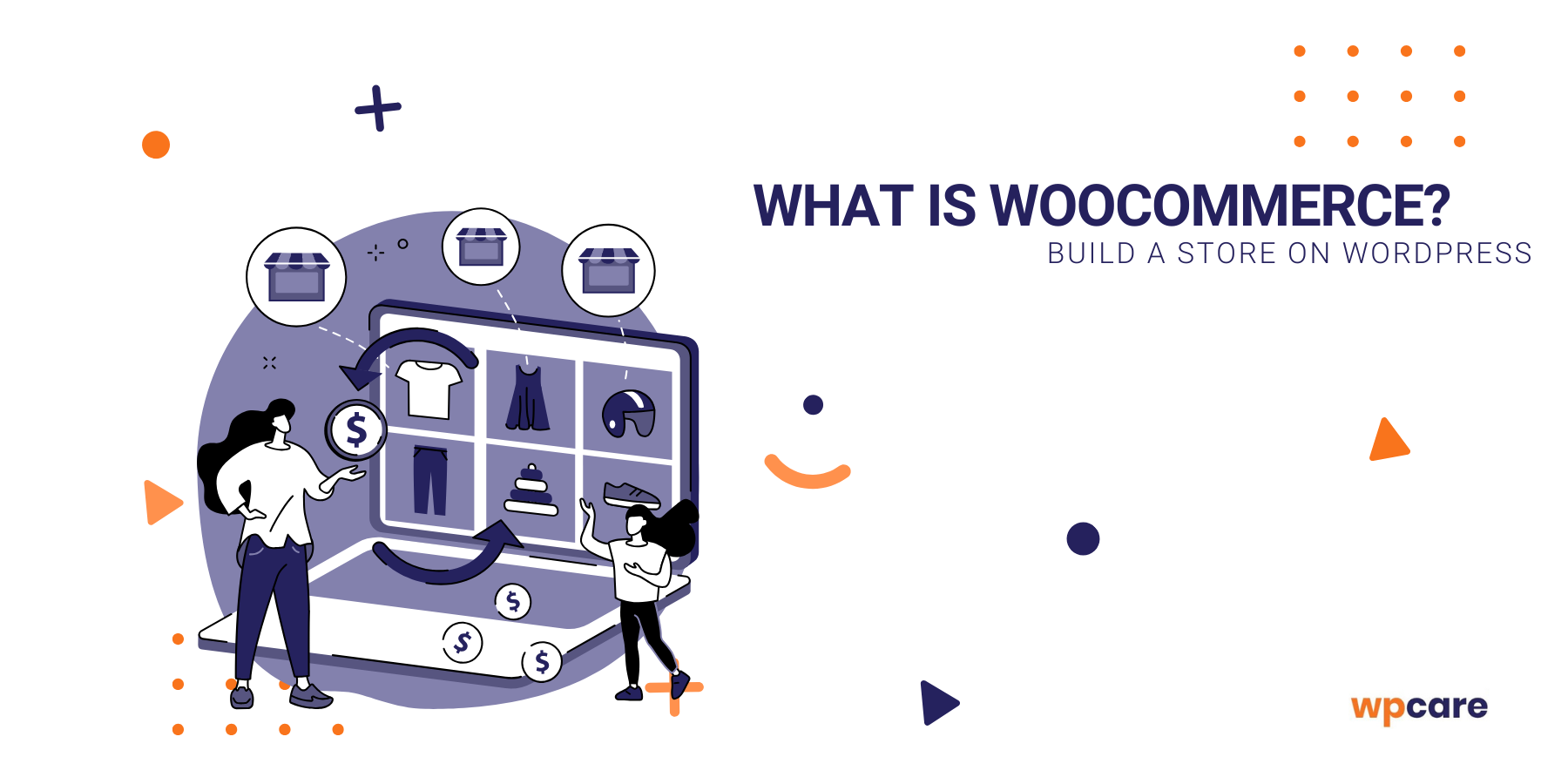The Polish e-commerce market, just like in other countries around the world, is developing exceptionally dynamically. According to a Gemius report from 2021, as many as 77% of Internet users shop online, and there are already 51,000 online stores operating in Poland.
One of the most popular technologies used in e-commerce websites is WooCommerce. But what exactly is it? And what does it have to do with WordPress?

What is WooCommerce?
WooCommerce is a WordPress plugin created by WooThemes that allows you to transform a regular website or blog into an online store. It is currently owned by Automattic – the same company behind WordPress.
The installation of WooCommerce is exactly the same as installing any other WordPress plugin. Simply go to the plugins section in your WordPress dashboard, search for it in the repository, click twice, and it’s done! From that moment, your site can function as, for example:
- an online store selling physical products,
- a subscription sales system,
- a distribution system for virtual products, such as music files, eBooks, or photos,
- a system for selling offline services, such as dance courses,
- system for selling online services, such as an online programming course,
- a system for selling or booking tickets.
Sounds great? But there’s more good news.
Benefits of WooCommerce – 7 reasons why it’s worth using
-
Free open source software
Firstly, the WooCommerce plugin is free open source software. This means that you can modify and adapt its code to your needs without incurring any fees (e.g., for licenses).
-
Easy expansion and tailored functionalities
Users who lack programming skills need not worry either. An online store based on WooCommerce can be easily expanded using hundreds of free extensions available in the official WooCommerce store or on external websites.
-
Intuitive interface
Thirdly, WooCommerce is extremely intuitive to use. Both the installation and initial configuration should not cause any problems, as a user-friendly installation wizard guides you through the entire process.
-
Versatility across industries
WooCommerce supports several sales models, making it suitable for a wide range of industries. Online examples include stores offering groceries, cosmetics, clothing, remote services, or even in-person service bookings.
-
SEO and mobile-friendly
The WooCommerce plugin is optimized for SEO (it generates search engine friendly URLs and useful breadcrumbs) and mobile devices (most dedicated themes are responsive), which is very important for online business.
-
Security
With WooCommerce, it’s also easy to ensure the security of your store. The plugin includes a module that handles the SSL protocol, and its dedicated community quickly identifies and fixes any potential security vulnerabilities.
-
Adaptation to the polish market
The plugin is continuously adapted to the realities of Polish e-commerce. All functionalities have been translated into Polish, and the number of extensions integrating WooCommerce with local courier services, payment systems, and warehouse-accounting services is growing.
Drawbacks of WooCommerce
It is important to remember that although WooCommerce performs excellently in e-business, it is not a comprehensive sales platform but merely a plugin. Consequently, it has its limitations.
In its basic version, WooCommerce provides fundamental marketing tools, as well as options for reporting, sales analysis, inventory management, and payment processing. Those with more advanced requirements for their online store will need to invest in additional extensions, which may incur extra costs.
How popular is the WooCommerce plugin?
Despite the aforementioned drawbacks, WooCommerce has not been stopped from becoming one of the most popular technologies in the e-commerce industry. In the ranking of the million most popular e-commerce websites by traffic, WooCommerce ranks first. It even surpasses other well-known platforms like Shopify, Magento, and PrestaShop.
In Poland, the situation is very similar. Although WooCommerce was originally developed and evolved in the United States, it struggled for many years to adapt to the Polish market. A milestone for its development locally was the introduction of multilingual support with version 2.2. Since then – roughly since 2014 – its popularity has surged, with users increasingly adopting WooCommerce. This has led to the emergence of additional extensions and plugins. According to the latest data from BuiltWith.com, WooCommerce currently ranks first in Poland among e-commerce technologies.
Did You Know?
WooCommerce was first published by its creators in September 2011. By January 2013, it had been downloaded 500,000 times. By August 2014, this number had risen to 4 million. According to data from 2022, WooCommerce has been downloaded nearly 162 million times in total!
What capabilities does WooCommerce offer?
The WooCommerce plugin is an excellent tool both for emerging small businesses and larger e-commerce sites, as well as for those who previously ran a WordPress site and want to expand it with e-commerce functionality. In these cases, the WooCommerce plugin and its dedicated extensions will be more than sufficient.
Products
As mentioned earlier, WooCommerce makes it easy to sell various types of products.
Adding and configuring products is simple and intuitive. First, you add the basic information about the product: name, description, price (and optionally a promotional price) and image, and then you specify its features and attributes (e.g., whether the product is available in a single variant or comes in different options such as colors).
At this stage, you will also find useful options for managing the product’s inventory and shipping details (such as weight and dimensions). It is also possible to set up up-sell and cross-sell options for a given product.
These features can, of course, be expanded with code or with ready-made extensions that introduce, for example, additional fields (such as an email field, date selection, or checkboxes).
Inventory
WooCommerce comes with basic inventory management functionalities. You can reserve a product while the order is being paid for, set stock thresholds, and enable email notifications for low stock or out-of-stock situations.
Shipping
It is hard to imagine running an online store without the ability to ship products. In WooCommerce settings, you can define shipping zones, i.e., groups of regions to which you are willing to ship products. You can also choose shipping methods (by default, flat rate, free shipping, and local pickup are available) and configure shipping options (e.g., enable a shipping calculator). A shipping class functionality is also available by default, which can be useful for stores offering products of various sizes.
In most cases, the above functionalities are sufficient to run an effective online store. However, they can be expanded, for example, to include more detailed shipping cost management or integration with selected postal operators or couriers. An example of such a solution is our custom WooCommerce FedEx plugin, which facilitates easy shipment handling within Poland (e.g., generating shipping labels and dispatch documents, or verifying that the entered data complies with FedEx guidelines).
Appearance
Modifying the appearance of a WordPress store is not difficult. Just like with a regular website, you can simply find a theme that meets your needs from the repository or external sources and install it on your server.
Before making a choice, however, it is important to check whether the theme is fully compatible with WooCommerce. Information about a lack of support for the selected theme will appear in the themes section of the WordPress dashboard.
Sometimes issues with a “broken” layout (e.g., on the product or category pages) may arise, even if everything initially appears neat. Such problems can usually be resolved by modifying the theme’s files using the woocommerce_content() function or hooks. This, however, requires programming knowledge, so less experienced users should consult a specialist or choose a different theme.
Payments
Configuring basic payment options in WooCommerce is possible in the plugin’s settings. By default, only a few options are available – bank transfer, check payment, cash on delivery, and PayPal.
Payment options can, however, be expanded with popular gateways such as Dotpay, Tpay, Przelewy24, or PayU. For some payment operators (e.g., PayU), free integration plugins are available in the WordPress repository. For other gateways, you might need to purchase plugins from external sources.
Integrations with external accounting and inventory systems
With dedicated plugins, WooCommerce can be integrated with virtually any external accounting system (e.g., inFakt, iFirma, or wFirma), sales management systems (e.g., Subiekt or Small Business), sales platforms (Allegro, Ceneo, or Nokaut), or review sites (e.g., Opineo, Zaufane Opinie). There are also extensions available that facilitate running product campaigns on Google Merchant Center or email marketing through Freshmail.
Although configuring WooCommerce requires some attention and resources, it is an exceptionally flexible tool for running an online store. The possibilities for optimization and personalization are almost limitless. If you have the necessary knowledge, you can expand the plugin with additional functionalities on your own (and without any fees). Those who cannot program can take advantage of ready-made commercial solutions or commission specialists to create custom functionalities.
Trust us
At WP Care, we have many years of experience in building and implementing extensions dedicated to WooCommerce and the WordPress platform. If you are having issues with configuration or are interested in a tailor-made plugin, be sure to contact us – we will definitely help you!




















































